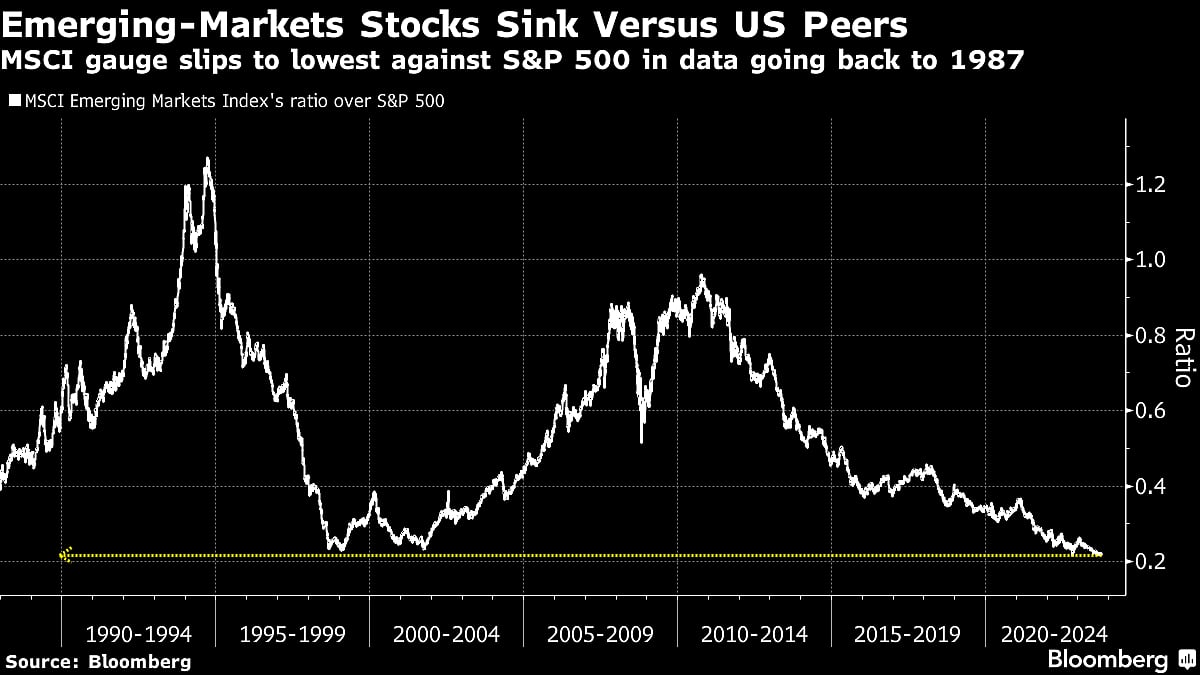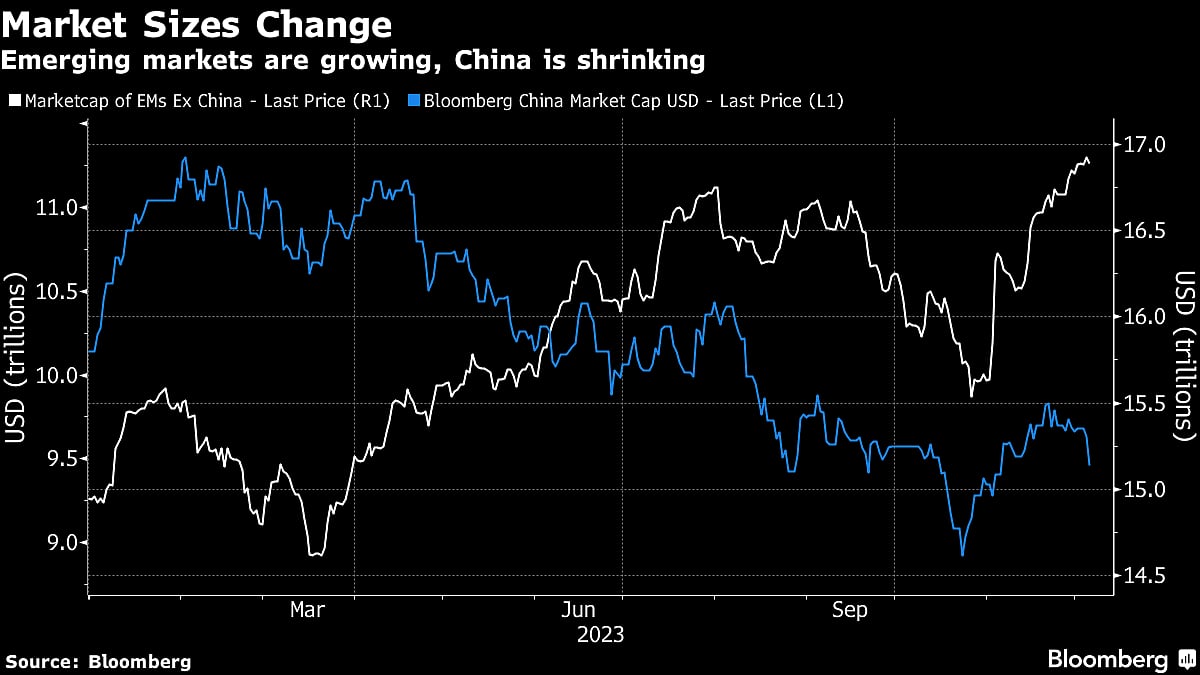Morgan Stanley IM Won’t Give Up On ‘Decade Of Emerging Markets’
Emerging-market stocks are underperforming the US this year by the widest margin since 1987.

(Bloomberg) -- Jitania Kandhari, senior manager at a $1.3 trillion arm of the investment bank Morgan Stanley, argues there’s still a way to claim victory for one of 2023’s boldest calls after it seemed to backfire.
Kandhari, deputy chief investment officer and head of macroeconomic research for emerging markets at Morgan Stanley Investment Management in New York, said in late January that the era of US stocks’ dominance was over and that the “decade of emerging markets” had begun.
With the year nearly over, that call looks like a flop.

Emerging-market stocks are underperforming the US this year by the widest margin since 1987, and have lost about 5% since Kandhari’s call was published in Bloomberg on Jan. 24. Investors in her fund, called the Passport Overseas Equity Portfolio, would have earned a respectable 7% return in 2023, almost double the emerging-market benchmark. But they’d have been far better off in the US, where the S&P 500 is up 24% and the Nasdaq is hitting new record highs, up 42%.
Morgan Stanley IM wasn’t alone if it got emerging markets wrong this year. California-based bond titan Pacific Investment Management Co. and Goldman Sachs Group Inc. were among others publishing positive views on the asset class early in the year. Japan’s biggest brokerage Nomura Holdings Inc. even announced mid-year that it’d be “scaling back up” its emerging-market credit desk in London after retreating from the business in 2019 and again in 2021.
Dig a little deeper into the 2023 numbers, though, and the picture becomes a bit more nuanced than just a bad call, Kandhari says. Strip emerging-market index heavyweight China out of the equation, as Kandhari advised in January, and emerging-market stocks ex-China have gained nearly 16% so far this year, heading for their best performance in four years.
Read more: Dodging China Slowdown, Investors Embrace EM Stock Darlings
In the US stock market, meanwhile, Kandhari points to gains driven largely by artificial intelligence-linked tech companies investors know as the “magnificent seven,” which are each up between 50% and 250%: Nvidia Corp., Apple Inc., Microsoft Corp., Amazon.com Inc., Alphabet Inc., Meta Platforms Inc. and Tesla Inc. Strip those out, and the US has underperformed Europe and emerging markets ex-China, she says.
“I have even more conviction at this point,” Kandhari said of her call for the start of an emerging-market decade. “It’s important to note that outside of the magnificent seven, the US market is barely up in low single digits. There’s a lot of distortions happening.”
While some of Kandhari’s argument centers on US valuations — she’s among those raising alarms about the current concentration of US stock gains and comparing it to the “Nifty Fifty Bubble” of the 1960s and 1970s, or the “dot-com bubble” of the 1990s — she’s still a believer that 2023 marked a turning point for emerging markets, an asset class that has underperformed the US for nine of the past 10 years.
“My call was based on fundamentals,” she said. “For the decade, I’m positive on this asset class, I think the fundamentals are aligned for the asset class to do well.”
The fundamentals she cites include higher relative growth expectations for emerging markets, better inflation dynamics, reduced leverage, more fiscal and monetary orthodoxy, and less of a hangover from extreme fiscal stimulus during the pandemic years.
“They haven’t done fiscal stimulus to the extent that the US has done,” she said. “And all of this is going to come to bite, like there’s no free lunch to do so much stimulus in the US.”
While declining to name specific companies, Kandhari said she liked companies in countries including India, Indonesia, Mexico, “all the supply-chain kind of countries,” and also commodity markets like Brazil. She’s also looking at emerging markets that will benefit from artificial intelligence-linked productivity gains, and she’s looking for value in smaller and frontier markets.
“Just today I told my analysts to look at some of these really smaller markets where currencies have depreciated in excess of 45, 50 percent,” she said. “Can we find light at the end of the tunnel for reform and for the growth upside?”
The main MSCI emerging-market currency index is up about 3.9% this year. But there are outliers, with the worst performances coming from Lebanon, Argentina, Nigeria, Angola, Turkey, Zambia, Pakistan and Egypt, all of which have currencies that dropped at least 20% against the dollar in 2023 alone.

As for China, Kandhari predicts it will be a long time before her fund is bullish on the country as a whole, citing uncertainty about how debt sitting in local government financing vehicles will ultimately be handled. Until then, she says she sees plenty of value in selective “pockets,” including automation, green technology, robotics, quantum computing and semiconductors.
“They’re playing like a whackamole game where the debt comes up somewhere, it gets put into something else,” she said of China. “So there’s this whole like sloshing of the debt going on, which is undermining productivity and growth.”
Ultimately she also expects China’s nearly 30% weight in the emerging-market index to decline, with other markets including India and Latin America taking a bigger share.
“Gone are the days of looking at the benchmark,” she said. “It’s going to be an evolving index.”
More stories like this are available on bloomberg.com
©2023 Bloomberg L.P.